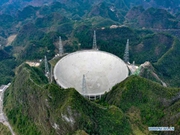

 |
| A model of China’s first Mars probe Tianwen-1 is displayed to the public at the 22nd China International Industry Fair held in east China’s Shanghai, Sept. 15, 2020. (Photo by Long Wei/People’s Daily Online) |
China’s first Mars exploration mission Tianwen-1 successfully slowed down for the third time near Mars at 06:29 a.m. on Feb. 24 Beijing time and entered the Mars parking orbit. The Mars probe will spend about three months conducting scientific surveys in the parking orbit.
Earlier on Feb. 10 Beijing time, the Tianwen-1 Mars probe reached the orbit around Mars after traveling in space for 202 days, becoming the country’s first man-made satellite of Mars.
Tianwen-1 probe embarked on its journey to Mars on July 23, 2020. After flying 475 million km in space, the spacecraft conducted a “braking” operation to decelerate and make sure it would be captured by Mars’ gravity, and then started to orbit the red planet. The successful completion of such key steps during the space voyage laid a solid foundation for the Mars exploration mission of China.
As a prime target for planetary exploration, Mars bears great significance to humanity’s dream of searching for extraterrestrial life and exploring mysteries of the universe.
The successful launch of the Tianwen-1 Mars probe marked China’s first step in independent planetary exploration as well as a key step of Chinese toward deeper space.
From endeavoring to establish its space station hundreds of kilometers above Earth’s surface to deepening exploration of the moon which is more than 380,000 km away from Earth and sparing no pains to explore Mars in spite of a long and arduous interstellar journey of several hundred million kilometers, China has achieved steady and solid progress in deep space exploration through persistent endeavors.
“Braking” in space is vital for the Tianwen-1 Mars mission. The successful arrival of the Tianwen-1 probe in Mars orbit has not only proven Chinese space scientists’ technical competence, but also demonstrated their aspiration and courage to make innovations despite high risks.
Space activities are known for being challenging, and planetary exploration is particularly featured by high risks and extreme difficulties. Mars exploration missions, which have been launched since the 1960s, only have an about 50 percent chance of success so far.
For every Mars exploration mission, mankind needs to tackle a great number of challenges and cope with various unknown hazards through technological innovations, including challenges posed by the fact that missions are only allowed to make one direct trip from Earth to Mars every 26 months due to the ever-changing positions of the planets, long space journeys of hundreds of millions of kilometers, delay in extremely long-distance communications, as well as a complex and alien environment that is entirely different from that of the Earth.
China, after a series of space endeavors, such as flying out of Earth, staying in space, and lunar exploration, has accumulated important technological breakthroughs, which help pave the way for the country’s Mars exploration and other deep space missions.
While dealing with new problems and new challenges through creative thinking and innovative technologies, the country has opened up new paths to innovations and breakthroughs in such fields as space technology and space science.
Motivated by curiosity and driven by the development needs of humanity, China’s magnificent feats of escaping from Earth’s gravity and moving toward deep space wouldn’t have been realized without its independent innovations.
China has witnessed continuous progress in scientific and technological projects in recent years, making heartening breakthroughs and record-breaking achivements in a considerable number of major projects.
Remarkable achievements of the country in recent years include scientific and technological innovations in the Tianwen-1 Mars exploration mission, Chang’e-5 lunar mission’s success in retrieving moon samples, the successful maiden flight of China’s new large carrier rocket Long March-5B, which was launched for the country’s space station program, new deep-sea manned submersible Fendouzhe, or Striver, setting a national diving record of 10,909 meters, and quantum computer prototype Jiuzhang helping China realizing a computational advantage, also known as “quantum supremacy”.
All these fruits have proven that as long as China maintains its determination and courage to make innovations and unswervingly march forward along its own path of independent innovation with Chinese characteristics, the country is bound to master core technologies in key fields and underpin high-quality development with scientific and technological strength.
 |

 Award-winning photos show poverty reduction achievements in NE China's Jilin province
Award-winning photos show poverty reduction achievements in NE China's Jilin province People dance to greet advent of New Year in Ameiqituo Town, Guizhou
People dance to greet advent of New Year in Ameiqituo Town, Guizhou Fire brigade in Shanghai holds group wedding
Fire brigade in Shanghai holds group wedding Tourists enjoy ice sculptures in Datan Town, north China
Tourists enjoy ice sculptures in Datan Town, north China Sunset scenery of Dayan Pagoda in Xi'an
Sunset scenery of Dayan Pagoda in Xi'an Tourists have fun at scenic spot in Nanlong Town, NW China
Tourists have fun at scenic spot in Nanlong Town, NW China Harbin attracts tourists by making best use of ice in winter
Harbin attracts tourists by making best use of ice in winter In pics: FIS Alpine Ski Women's World Cup Slalom
In pics: FIS Alpine Ski Women's World Cup Slalom Black-necked cranes rest at reservoir in Lhunzhub County, Lhasa
Black-necked cranes rest at reservoir in Lhunzhub County, Lhasa China's FAST telescope will be available to foreign scientists in April
China's FAST telescope will be available to foreign scientists in April